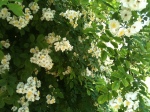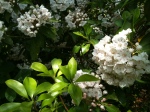
If a deer book tells you that echinacea is deer resistant, don't believe it!
Gardeners look forward to that magic time in early spring when new leaves unfurl and the first flush of green appears suddenly, everywhere. The problem is, deer look forward to it too and sometimes they feast on those new leaves before our gardens know what hit them! I know, first hand, because I’m lucky (and unlucky) enough to live on an old blueberry farm that has its own resident herd of deer.
The deer are great, don’t get me wrong. My kids never tire of seeing them nibble our fallen apples at the edge of the yard. It’s a thrill to catch sight of the buck, a rare occurrence, or several does grazing with their fawns. I’m glad they feel safe here and I understand that deer lived on this land before I arrived. I’m happy to share my aged fruit and vegetable scraps with them, but I’m not willing to let them browse through my perennial garden for dessert and believe me, if I lower my guard for an instant, they do.
Over the course of 15 years of trial and error, victory and loss, I’ve come to a few conclusions about what works and what doesn’t in the battle of gardener versus deer, or at least, me versus my particular deer. I’ve tried several remedies that don’t work, like using human hair and deodorant soap as deterrents. Perhaps my deer enjoy human scents? I’ve also heard of people tying white plastic bags throughout the garden to mimic a white-tailed deer warning. Sounds like a good idea, but I guess my sophisticated deer are not so easily fooled.
Of course, fencing is an option. The recommendation is to make your deer fence 8 feet high to prevent deer from soaring over it. No doubt that would work, but for me, fencing was neither aesthetically nor financially pleasing, so finally I tried the spray deterrents. Years ago, the deer repellant sprays needed to be reapplied after rain and irrigation and neither the deer nor I were impressed. Fortunately, there are a number of sprays today that will persist through both.
My personal favorite is Deer Off. It really works! An organic spray made from egg, garlic and cayenne, Deer Off will persist for four to five weeks, even during the rainy season or regular irrigation. Applying it may take a little while, especially if you have a large garden with many perennials and it does smell like wet dog until it dries, but hey, it really works! Both the smell AND the taste repel deer. There are some repellant sprays that only repel by taste and some granular repellants that only repel by smell, but from what I’ve found a spray that can do both, works best.
The trick, however, is not to be lulled into passivity. Any time after that 28th day, the deer will pounce and munch at my perennials’ expense. I mark my calendar and try to reapply the Deer Off shortly after the three-week mark, so even if I procrastinate and miss by a week (or two) I’m still okay.
I’m also not apt to follow the deer books too closely. Amazingly, they report that daylilies, Echinacea and black-eyed Susans are deer resistant perennials. My deer love daylilies and black-eyed Susans and Echinacea is their all-time favorite! They also feast on peegee and limelight hydrangeas, lythrum, hostas, burning bush, heliopsis and garden phlox. On the other hand, they’ve never eaten my oak leaf hydrangea, baptisia, iris (bearded or Siberian), bleeding heart, baby’s breath, sedum, salvia, perennial geranium, Russian sage or hellebore.
To be safe, I give everything a spritz, but it’s clear that deer prefer certain plants. If I let that Deer Off wear off, they’ll walk well into the garden, snubbing many plants along the way, to get to those peegees, limelights, daylilies, hostas and lythrum.
I can see that deer don’t dine on the native mountain laurel, inkberry, bayberry, viburnum, blueberry, chokeberry or clethra that grow in the woods that surround my property. I try to use these shrubs in my landscape, but I still can’t resist a hydrangea or two. This year I’ll be adding a few Forever and Ever hydrangeas, last year it was Endless Summers, but not to worry, I’m armed with a new gallon of Deer Off as well!
 If you’re walking or biking in South Jersey these days and are suddenly surrounded by a heavenly scent, you just may be passing by a mock-orange or wild rose in bloom. Both tend to ramble in overgrown brambly areas and on old properties. Mock Orange (Philadelphus var’s) has been cultivated for 400 years. Its white blooms open along long arching sprays and will fill a yard or a room with the scent of sweet orange – intoxicating!
If you’re walking or biking in South Jersey these days and are suddenly surrounded by a heavenly scent, you just may be passing by a mock-orange or wild rose in bloom. Both tend to ramble in overgrown brambly areas and on old properties. Mock Orange (Philadelphus var’s) has been cultivated for 400 years. Its white blooms open along long arching sprays and will fill a yard or a room with the scent of sweet orange – intoxicating!



